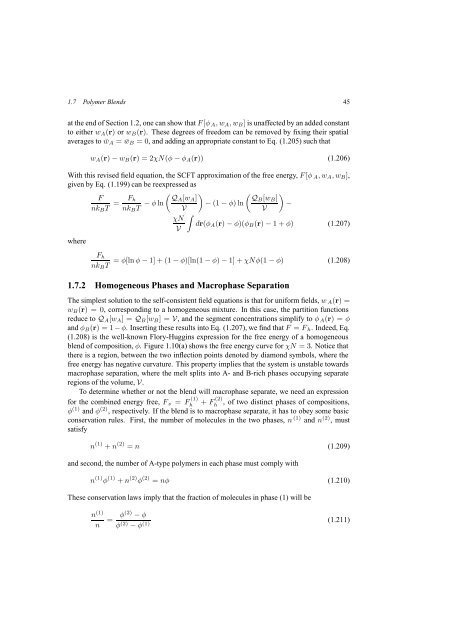Self-Consistent Field Theory and Its Applications by M. W. Matsen
Self-Consistent Field Theory and Its Applications by M. W. Matsen
Self-Consistent Field Theory and Its Applications by M. W. Matsen
Create successful ePaper yourself
Turn your PDF publications into a flip-book with our unique Google optimized e-Paper software.
1.7 Polymer Blends 45<br />
at the end of Section 1.2, one can show that F [φ A ,w A ,w B ] is unaffected <strong>by</strong> an added constant<br />
to either w A (r) or w B (r). These degrees of freedom can be removed <strong>by</strong> fixing their spatial<br />
averages to ¯w A =¯w B =0, <strong>and</strong> adding an appropriate constant to Eq. (1.205) such that<br />
w A (r) − w B (r) =2χN(φ − φ A (r)) (1.206)<br />
With this revised field equation, the SCFT approximation of the free energy, F [φ A ,w A ,w B ],<br />
given <strong>by</strong> Eq. (1.199) can be reexpressed as<br />
F<br />
nk B T = F ( )<br />
( )<br />
h<br />
nk B T − φ ln QA [w A ]<br />
QB [w B ]<br />
− (1 − φ)ln<br />
−<br />
V<br />
V<br />
∫<br />
χN<br />
dr(φ A (r) − φ)(φ B (r) − 1+φ) (1.207)<br />
V<br />
where<br />
F h<br />
nk B T<br />
= φ[ln φ − 1] + (1 − φ)[ln(1 − φ) − 1] + χNφ(1 − φ) (1.208)<br />
1.7.2 Homogeneous Phases <strong>and</strong> Macrophase Separation<br />
The simplest solution to the self-consistent field equations is that for uniform fields, w A (r) =<br />
w B (r) =0, corresponding to a homogeneous mixture. In this case, the partition functions<br />
reduce to Q A [w A ]=Q B [w B ]=V, <strong>and</strong> the segment concentrations simplify to φ A (r) =φ<br />
<strong>and</strong> φ B (r) =1− φ. Inserting these results into Eq. (1.207), we find that F = F h . Indeed, Eq.<br />
(1.208) is the well-known Flory-Huggins expression for the free energy of a homogeneous<br />
blend of composition, φ. Figure 1.10(a) shows the free energy curve for χN =3. Notice that<br />
there is a region, between the two inflection points denoted <strong>by</strong> diamond symbols, where the<br />
free energy has negative curvature. This property implies that the system is unstable towards<br />
macrophase separation, where the melt splits into A- <strong>and</strong> B-rich phases occupying separate<br />
regions of the volume, V.<br />
To determine whether or not the blend will macrophase separate, we need an expression<br />
for the combined energy free, F s = F (1)<br />
h<br />
+ F (2)<br />
h<br />
, of two distinct phases of compositions,<br />
φ (1) <strong>and</strong> φ (2) , respectively. If the blend is to macrophase separate, it has to obey some basic<br />
conservation rules. First, the number of molecules in the two phases, n (1) <strong>and</strong> n (2) , must<br />
satisfy<br />
n (1) + n (2) = n (1.209)<br />
<strong>and</strong> second, the number of A-type polymers in each phase must comply with<br />
n (1) φ (1) + n (2) φ (2) = nφ (1.210)<br />
These conservation laws imply that the fraction of molecules in phase (1) will be<br />
n (1)<br />
n = φ(2) − φ<br />
φ (2) − φ (1) (1.211)
















